Welcome to Chapter 7 of The Ultimate T-shirt Business Success Guide.
Launching a t-shirt business opens a world of creative possibilities, but making smart product selections is fundamental for success. T-shirts vary enormously in quality, style, fit, fabric, printing methods, and more. Thoughtfully navigating these options allows you to offer durable, comfortable shirts that align with your brand identity and resonate with target customers.
This guide provides in-depth knowledge on choosing ideal t-shirts to meet buyer expectations. We’ll explore popular styles, leading brands, fabrics like cotton blends and polyester, printing techniques and fabric interactions, and factors to optimize for your audience. With informed product choices, you can craft a strong brand identity and establish your footing in a thriving, competitive space.
Table of Contents
- T-shirt Styles
- Mens vs Womens
- T-shirt Fits
- Types of T-shirt Fabric
- Top T-shirt Brands
- Print Methods For Products
- Perfecting Product Selection

T-shirt Styles
- Crewnecks offer a versatile, classic fit favored for casual wear and promotions. With universal appeal, they are a staple t-shirt style.
- Long sleeves provide more coverage for cooler weather. They strike a comfortable balance between casual and polished looks, making them widely versatile.
- V-necks add subtle stylistic flair with a unique neckline, suited for semi-formal or smart casual settings.
- Sleeveless muscle shirts and tank tops cater to athletic and casual segments, offering ease of movement.
- Polos bridge the gap from casual to formal with a collar and buttons. They work well for office attire.
- Scoopnecks provide a more relaxed, feminine-leaning variant of the classic crewneck.
- Crop Tops pair well with high-waisted bottoms for a modern, youthful look.
Which Style is Best?
While versatile crewnecks have mass appeal, the ideal t-shirt style depends on your target audience. Analyze your market to select the right mix.
For broad reach, feature classic crewnecks as they resonate across demographics. But consider branching into specialized styles tailored to your buyers’ preferences. Fitness brands could offer muscle shirts, youth-focused companies may add crop tops, and fashion-forward lines might incorporate scoop necks.
Balancing reliable crewnecks with a few strategic variations broadens your accessibility for diverse tastes. Even if you lead with crewnecks, selectively diversifying provides more precise personalization.

Men's vs. Women's Styles
When selecting t-shirts, consider the different cuts designed for men and women. Variations cater to body shapes, sizing, and personal preferences.
Men's
Men’s t-shirts feature a straight, relaxed fit with broader shoulders and a less tapered torso. Common options include crewnecks or V-necks with standard sleeve lengths, suited for versatile everyday wear.
Women's
Women’s cuts accommodate narrower shoulders and a broader bust with a contoured, tapered shape. Sleeves tend to be more fitted, and necklines can be larger in styles like scoop necks. Lengths run longer for additional coverage.
Unisex
Unisex leans closer to the straight shape of men's styles, acting as a middle ground for all body types with a simpler, non-contoured fit focused on casual comfort. The straight cut and average sizing makes it widely accessible.
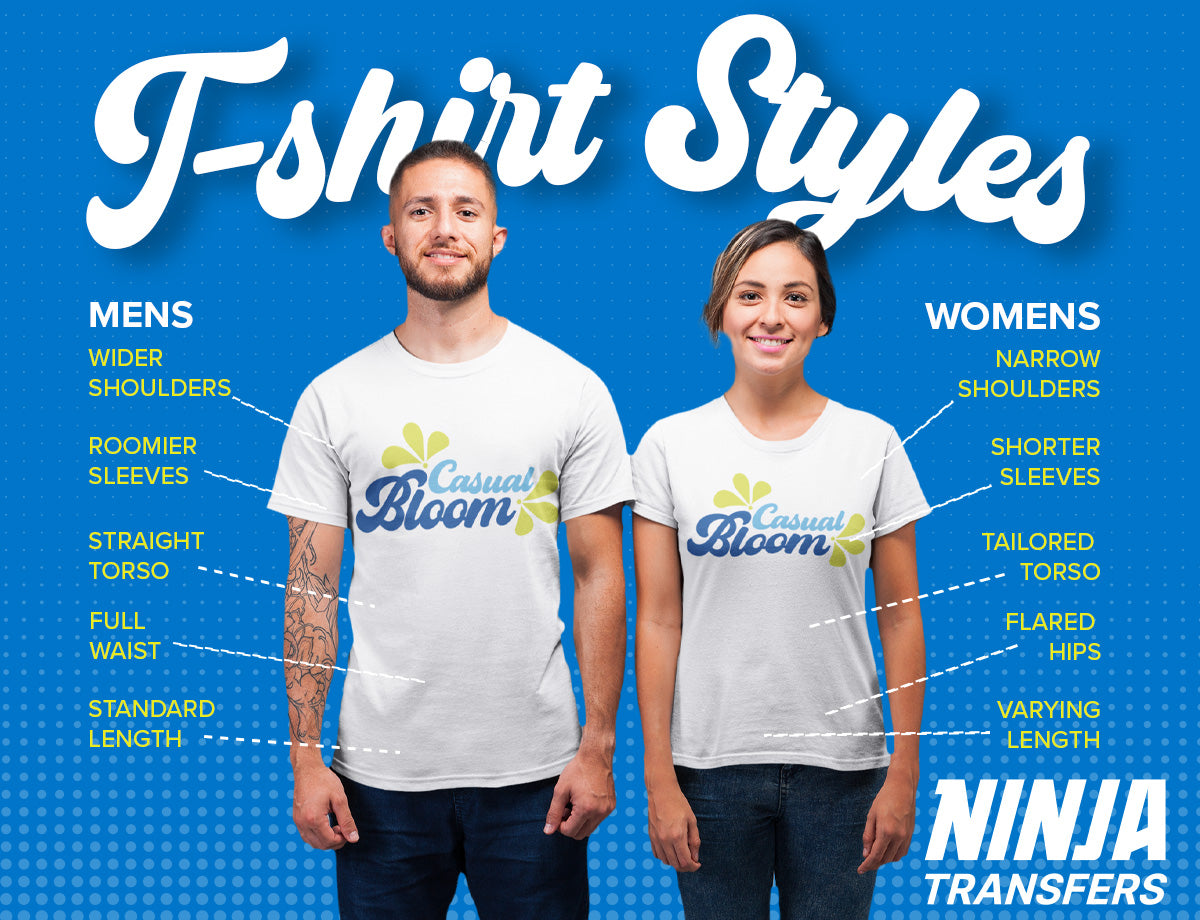
Should I sell women's styles?
Offering women's cuts meets rising demand and reflects an inclusive brand. The women's t-shirt market grows steadily, with an estimated growth rate of 6% from 2022 to 2028. Selling women's styles is expected in many markets, especially fashion-oriented brands.
Catering to this demographic signals attentiveness to diverse preferences. Including contoured, tapered fits designed for the female form demonstrates your commitment to supporting all customers. Expanding into this arena allows you to tap an eager segment and broaden your overall accessibility.
T-shirt Fits
In the t-shirt business, 'fit' refers to how the garment sits on the body, encompassing its overall shape and the way it drapes. The fit is a crucial aspect of a t-shirt's style and appeal, as it can significantly impact the look and feel of the shirt. Generally, three main types of fits cater to different preferences and body types.
Standard Fit
Standard fit t-shirts are known for their traditional, boxy shape. They offer a straight silhouette that doesn't conform closely to the body. This fit is widely used due to its universal appeal and suitability for various body types. However, the standard fit is often less flattering than more tailored options, as it doesn't accentuate the body's contours.
Slim Fit / Semi-Fitted
Slim fit, also known as semi-fitted, fashion fit, or retail fit, was popularized by brands like American Apparel, with many others following suit. This fit is closer to the body, offering a more contoured, modern look that accentuates the wearer's physique. While primarily featured in premium brands, some budget-friendly options are also available. Slim fit t-shirts have gained substantial popularity for their stylish and flattering appearance.
Relaxed Fit (Oversized)
Relaxed fit t-shirts, often termed oversized, provide a looser, more generous cut. They are designed for maximum comfort and ease, draping more freely over the body. This fit has gained popularity for its casual, laid-back vibe and is particularly favored in contemporary, fashion-forward circles.
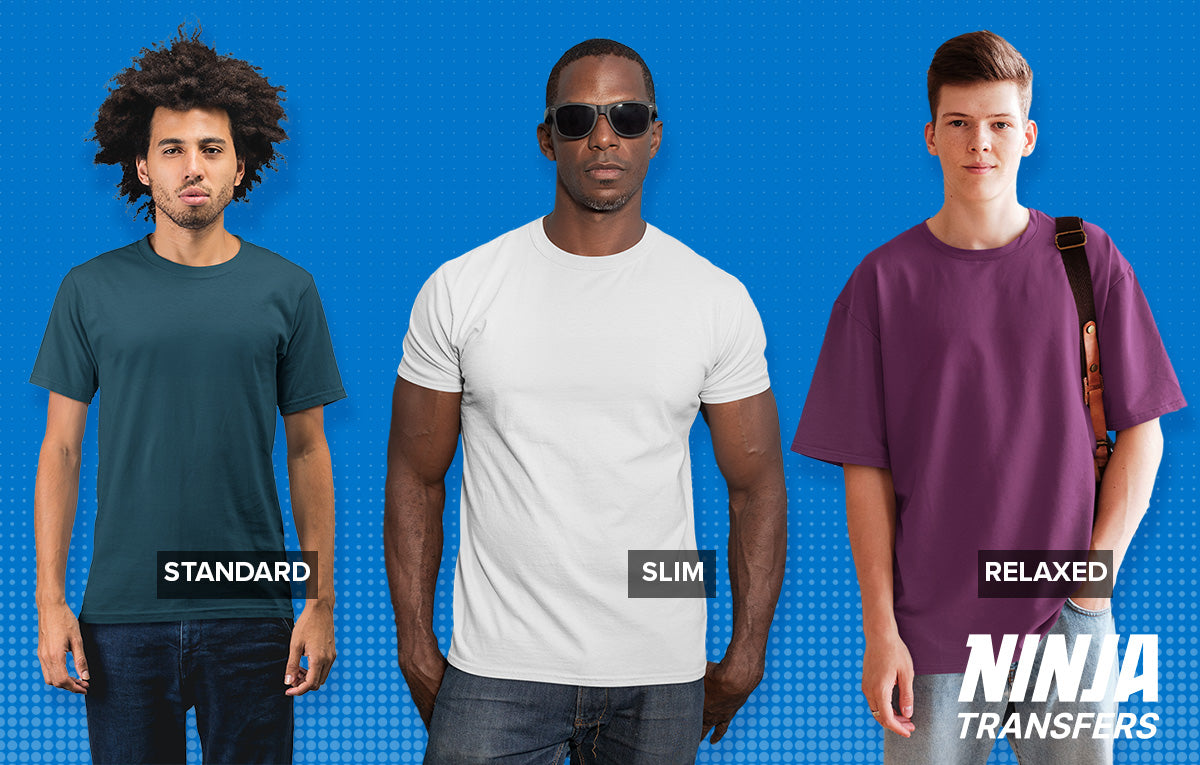
Which is Best?
It depends. The important thing is to carefully analyze which fit best aligns with your target demographic’s style preferences and buying considerations. That being said:
Many contemporary t-shirt retailers opt for the increasingly popular semi-fitted or “retail fit” to cater to fashion-forward segments. But oversized, relaxed fits drive current casual wear trends as well. Stick with versatile standard cuts if trying to appeal to the widest possible audience across style priorities.
Types of T-shirt Fabric
The fabric of a t-shirt plays a pivotal role in its overall feel, durability, and suitability for different printing methods. Understanding the characteristics of various t-shirt fabrics is crucial for making informed choices.
100% Cotton
Cotton is the most popular and commonly used t-shirt fabric. Known for its breathability and softness, it provides comfort and a classic feel. Cotton is highly versatile and compatible with most printing methods, including screen printing, direct-to-film (DTF), and direct-to-garment (DTG), though DTG is only effective on cotton. However, it can shrink when washed in hot water and may not be as durable as synthetic fabrics.
Polyester (Performance Fabric)
Polyester, often used in performance or athletic wear, is known for its durability, resistance to shrinking and wrinkling, and quick-drying properties. It is ideal for sublimation printing, which works best on synthetic fabrics like polyester. However, it may not be as breathable as cotton and can irritate sensitive skin.
Cotton/Poly Blend
Cotton/poly blends aim to offer the best of both worlds: the comfort and breathability of cotton with the durability and wrinkle resistance of polyester. These blends are versatile, suitable for various printing methods, and often provide a good balance between casual and athletic wear. However, they may not offer the same level of softness as pure cotton or the full performance qualities of polyester.
Tri-blend
Tri-blend fabric, typically a mix of cotton, polyester, and rayon, is among the softest t-shirt materials. It offers a unique combination of breathability, durability, and a silky feel, making it a popular choice for premium-quality shirts. However, they can be more expensive than single-fabric or dual-blend options.
CVC (Chief Value Cotton)
CVC fabrics are a cheaper alternative to tri-blends, usually made up of a higher percentage of cotton and a smaller percentage of polyester. Often found in a heathered look, CVC shirts offer softness similar to tri-blends but without the inclusion of rayon. While they provide comfort and are more budget-friendly, they might need to match the luxurious feel of tri-blends.
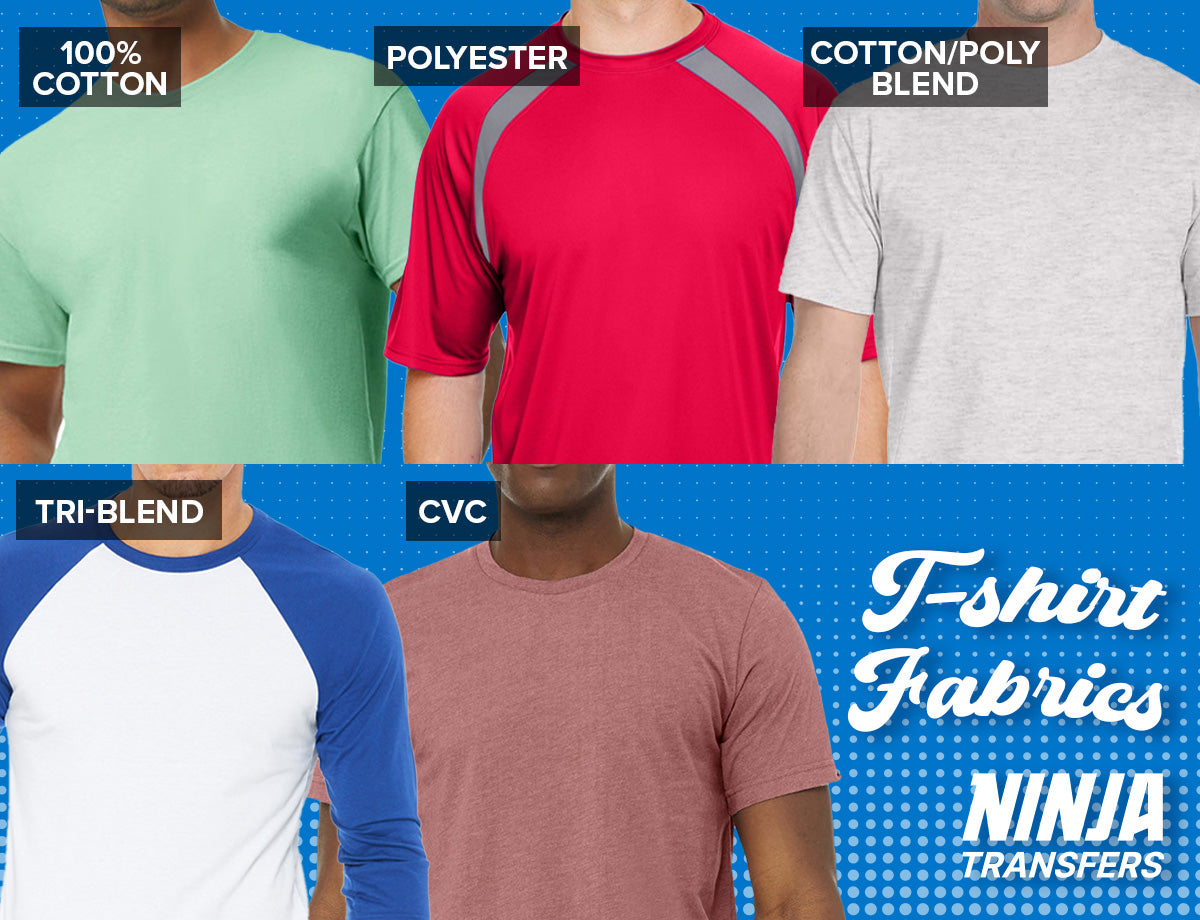
T-shirt fabric comparison chart
|
100% Cotton |
Cotton/Poly Blends |
100% Polyester |
|
✅ Soft ✅ Comfortable ✅ Breathable ✅ Gentle on skin ✅ Non-clingy ✅ Easily customized ✅ Hypo-allergenic ✅ Popular ❌ Generally heavier ❌ Prone to shrinkage ❌ Prone to stains ❌ Prome to wrinkles ❌ Slow to dry |
✅ Soft ✅ Comfortable ✅ Lighter weight ✅ More durable ✅ Better drape ✅ Less wrinkles ✅ Quicker drying ✅ Popular ❌ Can be clingy ❌ May be irritating to some ❌ Some restrictions on printing ❌ Slightly higher price point |
✅ Moisture-wicking ✅ Lightweight ✅ Super durable ✅ No shrinkage ✅ Limited wrinkles ✅ Odor resistant ✅ Wrinkle resistant ✅ Quick-drying ❌ Less breathable ❌ Can be clingy ❌ Synthetic feel ❌ Can irritate skin ❌ Restriction on printing ❌ Some higher price points |
|
Printing: Most print methods will work on cotton, except for sublimation printing. Cheaper cotton (carded open-ended) can result in poor print quality. DTG printing only works well on 100% cotton. |
Printing: DTG printing on blends can have quality issues. Screen printing or DTF transfers are recommended. |
Printing: DTG does not work on polyester, and screen printing can have issues. Sublimation is recommended, which only works on poly, is recommended. |
Which is Best?
We recommend starting out with cotton. It has versatile, longstanding popularity compatible with most printing methods, and will likely attract the widest demographic.
Increasingly, cotton-poly blends and tri-blends have become favorites. Customers discover softness and durability from added synthetics that retain cotton’s comfort. These blends provide a contemporary style as well.
We suggest ordering sample shirts - one 100% cotton, one cotton-poly, one tri-blend. Try them on to best understand the feel your customers could prefer day-to-day. And pay close attention to customer feedback.
Top T-shirt Brands
In the t-shirt business, selecting the right brand for your needs is as crucial as choosing the right style or fabric. While there is some overlap among categories, and pricing can vary due to competition, sales, and new product introductions, t-shirt brands generally fall into three main categories: budget, standard/moderate, and premium.
Budget Brands
Budget brands like Gildan, Alstyle, Hanes, Fruit of The Loom, and Jerzees offer affordable options. However, it's essential to be aware that budget t-shirts often come with certain limitations.
They may have a boxier fit and be made from 'carded open-ended' cotton, which is rougher and less desirable for print quality and comfort. Additionally, these shirts tend to be less durable over the long term.
While budget shirts can be suitable for free promotional items, they are generally not advised for your main product line due to these quality issues.
Standard/Moderate Brands
Brands like American Apparel, Bella+Canvas, Next Level, Threadfast, and Alternative Apparel fall into the standard or moderate category. These brands typically offer semi-fitted t-shirts made from combed and ringspun cotton, which enhances print quality, softness, and overall comfort.
These shirts are generally more durable and represent a significant improvement in quality from budget brands. They make them a solid choice for businesses that want to offer quality at a reasonable price.
Premium Brands
Premium brands include Champion, Columbia, Comfort Colors, Puma Sport, and some eco-friendly brands. T-shirts from these brands are often of higher quality, but the price sometimes reflects brand recognition as much as actual product quality.
It's also important to note that premium brand t-shirts may feature logos in areas where you intend to print, which can be a consideration for your designs.
While these brands are less commonly used for printing due to their cost and branding, they can appeal to a segment of the market that values brand recognition alongside quality.

Which is Best?
When choosing among the different categories of t-shirt brands for your business, we strongly recommend focusing on the standard/moderate category. Brands like Bella+Canvas, Next Level, Threadfast, and Alternative Apparel strike an ideal balance between quality and price.
They provide t-shirts that are not only made from better-quality materials like combed and ringspun cotton but also offer a more contemporary, semi-fitted style. This combination ensures higher print quality, increased comfort, and greater durability.
Selecting from this category allows you to offer your customers products that are a notch above budget options in terms of quality without the premium price tag associated with high-end brands.
This approach enhances customer satisfaction and positions your brand as one that values quality and affordability.
Pre-printing vs POD for Product Selection
The business model you choose holds significant implications for product selection around fabric, style, and inventory management.
Pre-Printing
A pre-printing model, traditionally leveraging screen printing, enables bulk runs at higher profit margins per unit. You gain more leeway around fabric and style variety without relying on an external POD supplier. However, constrain initial selections to proven popular options based on market testing. This prevents overextending into untested styles and causing inventory build-up issues.
POD (Print-on-Demand)
POD revolutionized enabling t-shirt sales without holding inventory, typically printing on-demand direct-to-garment (DTG). However, most POD relies on printing on cotton, limiting fabric options. The range of styles available also depends on the POD provider’s offerings, often more narrowly constrained. Carefully curate the selections you activate to avoid choice overload.
Do-It-Yourself POD with DTF Transfers
Blending flexibility with on-demand efficiency, DIY POD with DTF transfers facilitates printing any fabric types from a home or small workshop. You simply stock blank garments, allowing immense style variety without risk of wasted inventory. This empowers smaller brands to actualize wider creative visions without overextending.

Perfecting Product Selection for T-shirt Success
Choosing the right t-shirt products involves multiple considerations that shape brand identity and customer appeal.
Carefully weigh style and fit options suited to your target demographic. Understand how fabrics like versatile cotton, soft blends, and premium materials align with audience expectations. Consider how your business model and its inventory implications allow you to actualize creative ambitions.
Getting these fundamentals right ensures your product selections resonate. But the journey continues in understanding how to best showcase offerings through tailored e-commerce platforms.
Ninja Blanks offers a wide range of quality products tailored to meet the diverse needs of t-shirt businesses, providing you with the perfect canvas to bring your designs to life.
Check out our next chapter on the best online storefronts for selling t-shirts, where we'll dive into the world of e-commerce platforms and how to choose the best online storefront to showcase and sell your t-shirt creations.
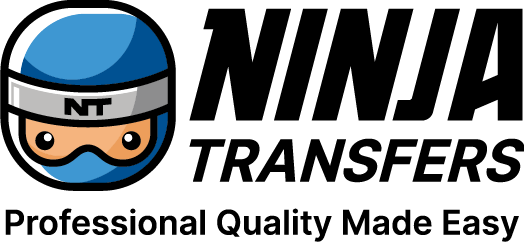
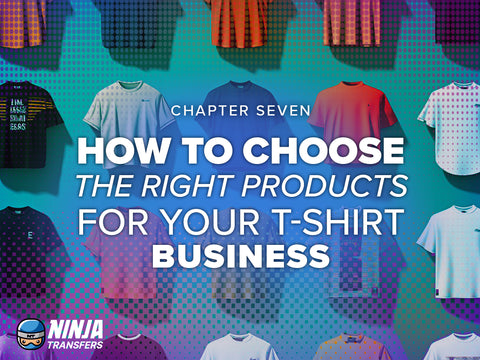
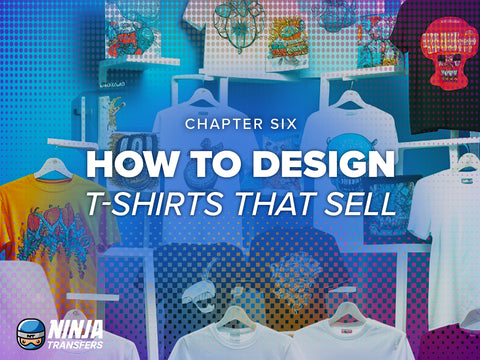
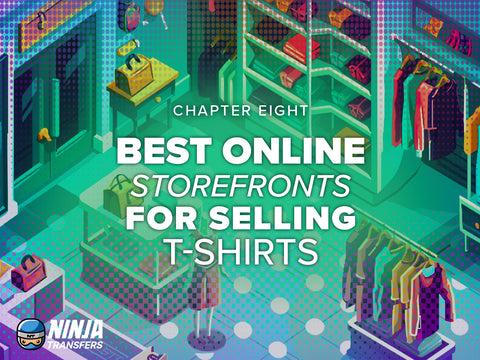
评论 (0)
这篇文章没有评论。成为第一个在此留言的人!